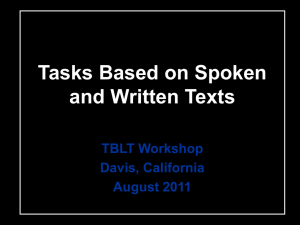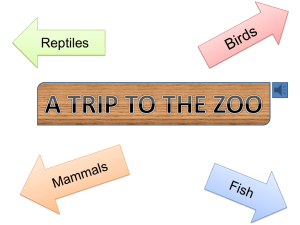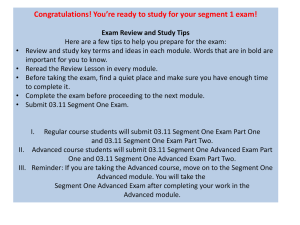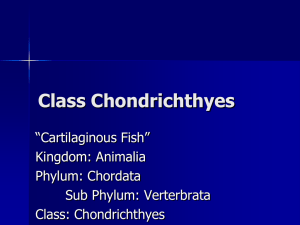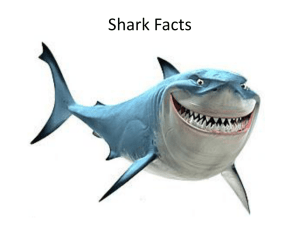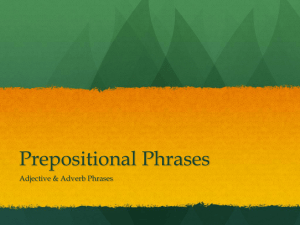OAKS-3 - 4J Blog Server
advertisement
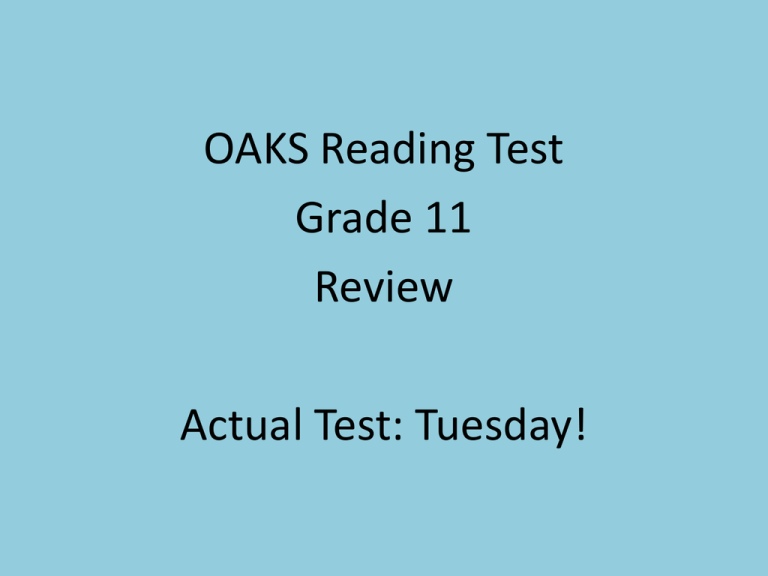
OAKS Reading Test Grade 11 Review Actual Test: Tuesday! What the OAKS test is actually testing for… • • • • • Vocabulary Read to Perform a Task Demonstrate General Understanding Develop an Interpretation Examine Content and Structure: Informational Text • Examine Content and Structure: Literary Text For sample tests and supplemental information see: http://www.oaks.k12.or.us/portal/ For Sample Tests: -click on Students -then Practice Tests -then enter through the password information -then set the Student Grade as 11 and hit YES -you can choose Reading or Writing -then enter through the next two windows until it gives you a test… ***They say they will let you take 10 sample tests before locking you out of the site THE LEARNING CURVE by David Sedaris is an acclaimed novelist and satirist who is often heard on National Public Radio’s “This American Life.” In the chapter entitled “The Learning Curve,” from his autobiographical book ME TALK PRETTY ONE DAY, Sedaris relates events from his initial foray into teaching. A YEAR AFTER MY GRADUATION from the School of the Art Institute of Chicago, a terrible mistake was made and I was offered a position teaching a writing workshop. I had never gone to graduate school, and although several of my stories had been Xeroxed and stapled, none of them had ever been published in the traditional sense of the word.Like branding steers or embalming the dead, teaching was a profession I had never seriously considered. I was clearly unqualified, yet I accepted the job without hesitation, as it would allow me to wear a tie and go by the name of Mr. Sedaris. My father went by the same name, and though he lived a thousand miles away, I liked to imagine someone getting the two of us confused. “Wait a minute,” this someone might say, “are you talking about Mr. Sedaris the retired man living in North Carolina, or Mr. Sedaris the distinguished academic?” The position was offered at the last minute, when the scheduled professor found a better-paying job delivering pizza. I was given two weeks to prepare, a period I spent searching for a briefcase and standing before my full-length mirror, repeating the words “Hello, class, my name is Mr. Sedaris.” Sometimes I’d give myself an aggressive voice and firm, athletic timbre. This was the masculine Mr. Sedaris, who wrote knowingly of flesh wounds and tractor pulls. Then there was the ragged bark of the newspaper editor, a tone that coupled wisdom with an unlimited capacity for cruelty. I tried sounding businesslike and world-weary, but when the day eventually came, my nerves kicked in and the true Mr. Sedaris revealed himself. In a voice reflecting doubt, fear, and an unmistakable desire to be loved, I sounded not like a thoughtful college professor but, rather, like a high-strung twelve-year-old girl; someone named Brittany.My first semester I had only nine students. Hoping they might view me as professional and well prepared, I arrived bearing name tags fashioned in the shape of maple leaves. I’d cut them myself out of orange construction paper and handed them out along with a box of straight pins. My fourthgrade teacher had done the same thing, explaining that we were to take only one pin per person. This being college rather than elementary school, I encouraged my students to take as many pins as they liked. They wrote their names upon their leaves, fastened them to their breast pockets, and bellied up to the long oak table that served as our communal desk. “All right then,” I said. “Okay; here we go.” I opened my briefcase and realized that I’d never thought beyond this moment. The orange leaves were the extent of my lesson plan, but still I searched the empty briefcase, mindful that I had stupidly armed my audience with straight pins. I guess I’d been thinking that, without provocation, my students would talk, offering their thoughts and opinions on the issues of the day. I’d imagined myself sitting on the edge of the desk, overlooking a forest of raised hands. The students would simultaneously shout to be heard, and I’d pound on something in order to silence them. “Whoa people,” I’d yell. “Calm down, you’ll all get your turn. One at a time, one at a time.” The error of my thinking yawned before me. A terrible silence overtook the room, and seeing no other option, I instructed my students to pull out their notebooks and write a brief essay related to the theme of profound disappointment. 1- When the narrator says, “I had stupidly armed my audience with straight pins,” he means A. that his students won’t agree to make a bulletin board with the leaves and pins. B. That the straight pins ended up having no practical purpose. C. jokingly that his students might attack him with the pins. D. that the class could fall apart as students poke each other with pins. 2- The narrator ends the essay with the sentence “A terrible silence overtook the room, and seeing no other option, I instructed my students to pull out their notebooks and write a brief essay related to the theme of profound disappointment.” This is effective irony because the narrator A. assumes that the students came prepared with notebooks. B. had not actually planned to require students to write in class. C. had such high hopes of his own for this experience. D. was aware a first writing assignment should never be so negative. 3- The narrator describes his tone of voice on his first day of teaching as A. doubtful and fearful. B. aggressive and firm. C. wise and cruel. D. businesslike and weary. 4- In the second paragraph, the author uses the sentence, “like branding steers or embalming the dead, teaching was a profession I had never seriously considered.” He does this in order to A. show how many other unusual jobs he has tried. B.create a sense of danger and excitement. C. show how little thought he had given to the profession of teaching. D. create a sense of foreshadowing for the rest of the story. 5- The narrator says, “The error of my thinking yawned before me.” This is another way of saying that A. the narrator is confident that no one will notice his mistakes. B.the entire class yawns at the narrator’s boring lesson. C. the narrator is so sleepy it is hard for him to think. D. the narrator now understands the consequences of not planning ahead. YIKES! SHARKS! When most of us hear Michael Crichton’s name, we think of JURASSIC PARK and other popular science fiction books and movies. He has also written much nonfiction, however, including a book entitled TRAVELS, from which this excerpt is taken. At this point in the book, Crichton talks about his experiences during a dive taken with other members of his family. THE TUAMOTUS WERE OLD ISLANDS; their volcanic peaks had been eroded until they finally disappeared, and nothing remained but the coral reef that had originally surrounded the island, but now merely enclosed a lagoon.On Rangiroa, the lagoon was enormous—some twenty miles in diameter. There were only two breaks in the enclosing reef, through which the tides came and went twice a day. So much water, moving through just two passes, meant that tidal currents were strong indeed. It also meant that lots of fish were attracted tothe pass, because of the great nutrient flow in the water.“It is very exciting,” the proprietor said. “You must do it.”We went to Michel, the divemaster, and said we wanted to dive the pass. He consulted a tide table, and said we would do it at ten the following morning. (You can only dive the pass when the tide is running into the lagoon. Otherwise you risk being swept out to sea.) We went down. It wasn’t until we got near the bottom that I realized how fast we were moving. The current was really ripping. It was tremendously exciting—if you didn’t mind being out of control. It didn’t matter whether you were facing forward, backward, or sideways: the current moved you at the same swift pace. You couldn’t stop yourself, you couldn’t hold on to anything. If you grabbed a piece of coral, you’d either rip it off or rip your arm off. You were just swept along by the current, in the grip of a force orders of magnitude greater than you could possibly fight. There was nothing to do but relax and enjoy it.After the first few minutes, after getting used to seeing the others perpendicular to the current, or looking up, clearing their masks, or facing backward, but always carried along at the same pace, it became fun. It was a kind of amusement park ride, and our powerlessness became pleasant.Then I saw the sharks.At first they were moving at the limit of my vision, the way I am used to seeing sharks, gray shadows where the water turns deep blue-gray, far from you. Then, as I came closer, the shadows gained definition, I could see details, and I could see more sharks. Lots more.The current was carrying us into the middle of a school of gray sharks, so numerous that it felt as if we were entering a cloud of animals. There were easily a hundred sharks circling in a large cluster. I thought, Oh my God. I didn’t want to go right through the middle. I preferred to go to one side, but the current was uncontrollable and indifferent to my preferences. We were going right through the middle of them. In an effort to control my panic, I decided to take a picture. I stared down at the exposure settings on the Nikonos around my neck, feeling slightly idiotic: Here you are in the middle of a hundred sharks and you are worrying about whether the f-stop is f8 or f11. Who cares! But it was one of those situations; there was nothing I could do about it, so I might as well think about something else, and I took a picture. (It came out very blurred.) By now the sharks were all around us, above and below and to all sides. We were being swept along by the current, like passengers riding a train, but they did not seem affected by it; they swam easily, flicking their powerful bodies with that peculiar lateral twisting that makes their movements so reminiscent of snakes. The sharks turned away, came back, spiraled around us, but I noticed that they never came close. And already we were moving clear of the cluster, swept onward by the current, drifting away from the compact cloud of sharks. And then gone. My breathing had not returned to normal when Michel jerked his thumb, gestured to me that we were to go down into the crevasse he had mentioned. He was twenty yards ahead of me. • I saw him swept across the bottom, and then he ducked down headfirst and disappeared into a trench. I saw a cloud of his bubbles rise as I was swept toward the trench. I also swung over, had a quick glimpse of a shallow little canyon perhaps ten feet deep, and twenty feet long. I was much relieved to be out of the current, but unexpectedly found myself in a black cloud of surgeonfish. These plate-sized fish, moving in dense, impenetrable schools, seemed agitated. I presumed it was because of the arrival of divers into the trench. Then the black cloud cleared, and I realized it was because of the sharks in the trench. A dozen gray sharks swam in the far end of the cul-de-sac. They were each about nine feet long, dull- snouted, beady-eyed. They swam irritably, within a couple of feet of me and Michel. I was vaguely aware of Michel, ever calm, looking at me to see how I was taking this. I was only looking at the sharks. I had never been so close to so many sharks at one time, and a dozen impressions assailed me. The gritty texture of their gray skin (sharkskin). The occasional injuries, white scars, and imperfections. The clean gill lines. The unblinking eye, menacing and stupid, like the eye of a thug. The eye was almost the most terrifying thing about a shark, that and the slashing curve of the mouth. And I saw the way one shark, hemmed in by us, arched his back in what I had recently read was typical gray-shark threat behavior that often presaged an attack—The other divers came swinging over the lip, blowing bubbles. The sharks fled. The last of them threaded his way between us as if we were pylons on an obstacle course. Or perhaps he was just showing off. 6- In this selection, the phrase “orders of magnitude” is used A. as a specific scientific measurement of the force of the current. B. as hyperbole to emphasize the force of the current. C. as an explanation of the relaxing and enjoyable sensation of being in the current. D. to explain why things seemed so clear and large, even in the depths of the water. 7- The reason the current was so strong, “really ripping,” was that A. the nature of the volcanic peaks of the islands created those kind of currents. B. incredibly strong currents swirled chaotically around the circular reef. C. the channels and trenches on the ocean floor caused exceptionally strong currents. D. the tides had to pass through just two openings in the reef. 8- The reason Crichton thought about having the correct settings on his camera while encircled by a hundred sharks was that he A. wasn’t really afraid of the sharks. B. wanted to prove what happened. C. decided to take his mind off the sharks. D. is a perfectionist about his photographs. 9- Crichton implies that the only time a shark may have posed a danger was when the shark A. was boxed in by the divers in the cul-de-sac. B.heard the motorized shutter of his camera. C. was swept helplessly by the current. D. may have felt threatened by divers blowing bubbles. 10- The purpose of this selection is most likely to show the reader that A. Crichton and his family are extraordinarily brave. B.Crichton and his family take foolish risks. C. many animals we deeply fear are usually not dangerous. D. everyone would enjoy thrill-seeking adventures. OAKS Writing Test Grade 11 Review General Information: • You must choose one prompt and write one paper of no more than 850 words • You will be given four prompts, one for each of the following writing styles: Expository, Persuasive, Descriptive, and Narrative • Once you have chosen a prompt you have two class days to complete your final draft (and additional time outside of class if you require it) Expository Writing: • Key words for an expository prompt: ‘Explain’, ‘Write and explanation’, ‘Inform’, ‘Examine’, ‘Discuss’, etc. • Expository essays are the most common essay written for classes. Their aim is to inform your reader on a particular topic. • Structure is key to a good expository essay. You must have an introduction with a good, clear thesis, body paragraphs that focus on your key points, and a conclusions that ties everything together. Persuasive Writing: • Key words for Persuasive prompt: ‘Write and essay to convince…’, ‘Persuade’, etc. • Persuasive essays should show two sides of a subject, but should also show your obvious preference for one side. Their aim is to persuade your reader that your chosen side is right. • You should avoid using words like ‘maybe’, ‘possibly’, etc, and use certainty instead (i.e. ‘one knows’, ‘ is certain’, etc). • Structure of persuasive writing is important. Your thesis statement should be a strong, clear opinion about the chosen prompt but should not use first person “I” (i.e. “High school athletes should avoid creatine.”). Your body paragraphs should address the main points for your argument (i.e. 1Loading up on creatine is unnatural 2- Harmful side affects are possible 3It isn’t wisely used), as well as addressing the counter-argument to your opinion. And, your conclusion, as always should restate your opinion and connect the main points together. Imaginative Writing: • Key words for an imaginative prompt: ‘Make up a story’, ‘Write an imaginative story’, etc • Imaginative writing focuses on a good description of character and imagery. They often use sensory details, and figurative language to ‘paint’ a picture of your chosen prompt. • Structure of imaginative writing is less important than expository or persuasive writing, but a difficulty students may face is having a descriptive piece of writing without purpose. Be sure there is a clear story line with plot development, or character development in your piece of writing. Narrative Writing: • Key words for a Narrative prompt are: ‘Tell a true story’, ‘Tell about’, ‘Recount a time when…’, etc • Narrative writing focuses on a personal story, retold by you. They often use sensory details, and figurative language to ‘paint’ a picture of your chosen story. • Structure of narrative writing is less important, much like in imaginative writing. However, as with imaginative writing, students often face difficulty with writing a story that has a clear purpose. Be sure there is a clear story line with plot development, and character development in your piece of writing. And focus on details that help the story ‘come alive’ for your reader.
